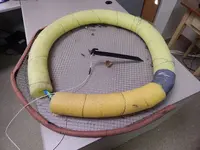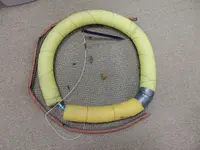View attachment 1047533View attachment 1047534
Here it is. You'll need pool floaties, a hoola hoop, wire, a rubber hose, duct tape, maybe a plastic stake, and 1/2" steel screen. Use the hoola hoop inside the floaties to make a frame, (you can make it as large as you like) and then cut screen to lap over floaties. Tie the custom cut screen around the floaties with wire (I also used an old rubber hose split to cover the pointy, sharp wire edges). I saw this design on arrowheadology a guy out in texas was using. After you put it into a deep enough area in flowing water and anchor it so that it stays put, it floats and you can shovel in gravel/sand bars and the flow of water quickly removes all small stuff and you're left hopefully with something nice occasionly. There are many others on this forum that have much more experience and success with creek/river searching who probably use something much better. You need to know the laws in your state. I think they differ from state to state. The creek I search runs through the middle of my property.





 I have abandoned many at old sites thinking I would go back and never did.
I have abandoned many at old sites thinking I would go back and never did.